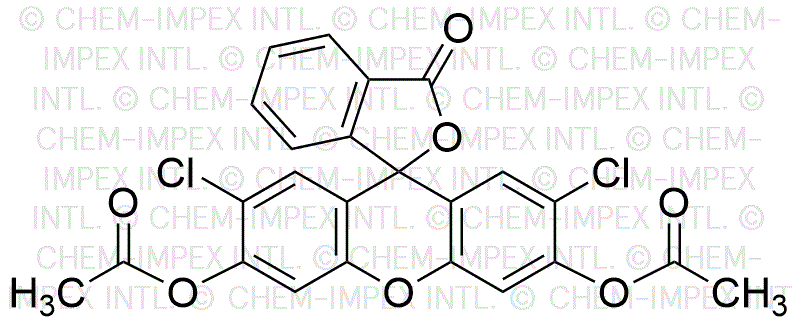2',7'-Dichlorofluorescein diacetate is widely utilized in research focused on:
- Cell Viability Assays: This compound is commonly used in assays to assess cell viability and proliferation, providing researchers with a reliable method to evaluate the health of cultured cells.
- Fluorescence Microscopy: It serves as a fluorescent dye in microscopy, allowing for the visualization of cellular components and processes, which is crucial in fields like cell biology and pharmacology.
- Drug Development: In pharmaceutical research, it is used to study drug effects on cellular functions, helping in the identification of potential therapeutic compounds.
- Biochemical Pathway Analysis: The compound aids in tracking metabolic pathways in live cells, providing insights into cellular responses to various stimuli or treatments.
- Environmental Monitoring: It can be employed in environmental science to detect and quantify biological activity in water samples, contributing to ecological studies and assessments.
General Information
Properties
Safety and Regulations
Applications
2',7'-Dichlorofluorescein diacetate is widely utilized in research focused on:
- Cell Viability Assays: This compound is commonly used in assays to assess cell viability and proliferation, providing researchers with a reliable method to evaluate the health of cultured cells.
- Fluorescence Microscopy: It serves as a fluorescent dye in microscopy, allowing for the visualization of cellular components and processes, which is crucial in fields like cell biology and pharmacology.
- Drug Development: In pharmaceutical research, it is used to study drug effects on cellular functions, helping in the identification of potential therapeutic compounds.
- Biochemical Pathway Analysis: The compound aids in tracking metabolic pathways in live cells, providing insights into cellular responses to various stimuli or treatments.
- Environmental Monitoring: It can be employed in environmental science to detect and quantify biological activity in water samples, contributing to ecological studies and assessments.
Documents
Safety Data Sheets (SDS)
The SDS provides comprehensive safety information on handling, storage, and disposal of the product.
Product Specification (PS)
The PS provides a comprehensive breakdown of the product’s properties, including chemical composition, physical state, purity, and storage requirements. It also details acceptable quality ranges and the product's intended applications.
Certificates of Analysis (COA)
Search for Certificates of Analysis (COA) by entering the products Lot Number. Lot and Batch Numbers can be found on a product’s label following the words ‘Lot’ or ‘Batch’.
Numéro de catalogue
Numéro de lot/série
Certificates Of Origin (COO)
This COO confirms the country where the product was manufactured, and also details the materials and components used in it and whether it is derived from natural, synthetic, or other specific sources. This certificate may be required for customs, trade, and regulatory compliance.
Numéro de catalogue
Numéro de lot/série
Safety Data Sheets (SDS)
The SDS provides comprehensive safety information on handling, storage, and disposal of the product.
DownloadProduct Specification (PS)
The PS provides a comprehensive breakdown of the product’s properties, including chemical composition, physical state, purity, and storage requirements. It also details acceptable quality ranges and the product's intended applications.
DownloadCertificates of Analysis (COA)
Search for Certificates of Analysis (COA) by entering the products Lot Number. Lot and Batch Numbers can be found on a product’s label following the words ‘Lot’ or ‘Batch’.
Numéro de catalogue
Numéro de lot/série
Certificates Of Origin (COO)
This COO confirms the country where the product was manufactured, and also details the materials and components used in it and whether it is derived from natural, synthetic, or other specific sources. This certificate may be required for customs, trade, and regulatory compliance.

